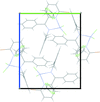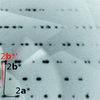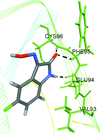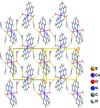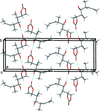issue contents
July 2017 issue

Cover illustration: Rubidium hydrogen carbonate, RbHCO3, is dimorphic and shows a structural phase transition from the monoclinic high-temperature phase to the triclinic low-temperature phase. In the high-temperature phase the hydrogen atom of the HCO3- anion is statistically disordered between symmetry-related pairs [HCO3]22- whereas it is ordered in the low-temperature phase, leading to one short and two symmetry-equivalent intermediate C-O bonds and to two short and one longer C-O bonds, respectively. The ordering of the proton leads to a translationangleiche symmetry reduction of index 2. See: Larvor & Stöoger [Acta Cryst. (2017). E73, 975-979].
research communications


















































































 journal menu
journal menu












